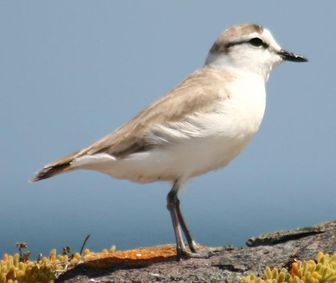White-fronted Plover
Adults are 16–18 cm in length, and are paler than similar species. The breeding adult has medium brown upperparts, with a white hind neck collar and a brilliant white forehead extending back in a conspicuous wedge between the eye and the crown. There is a black line through the eye and a black frontal bar to the crown. The underparts are white with a variable cream or buff wash to the breast. There may be rufous patches on the breast sides. The bill is black and the legs yellowish-grey.

Original source: Charadrius_marginatus.jpg: MBoy68
Author: Charadrius_marginatus.jpg: MBoy68
The White-fronted Plover is classified as Least Concern. Does not qualify for a more at risk category. Widespread and abundant taxa are included in this category.
The White-fronted Plover is a characteristic bird of Afrotropical beaches, from Liberia in western Africa to Somalia in eastern Africa, with a small isolated population in Senegal. It also inhabits tropical rivers and lakes with sandy shorelines. The coastal populations appear to be sedentary with local movements into estuaries during winter storms. Birds of the inland sand rivers move to adjacent coastlines, mainly towards the east, when the rivers are in flood. More
for White-fronted Plover and 42% for Kittlitz's Plover. The main cause of nest loss was flooding on the equinoxial spring tide. Although chicks were not ringed and the fates of individuals could not be determined, chick survival was presumably very low since no chicks older than a few days of age were seen. More
The White-fronted Plover's breeding habitat is sandy beaches; the eggs are laid directly on the sand, and may be buried. The adults will take water to the nest in their breast feathers. It feeds actively with fast runs like a Sanderling, usually hunting by sight for insects, crustaceans and worms. This is a gregarious species which forms flocks, often with other waders. The call is a clear wiit, and there is a tukut alarm note. More
White-fronted Plover nest with eggs on the beach. Author's comment I was scanning the beach after seeing a chick and was looking for more young ones to photograph when I saw this nest with eggs. 3Average: 3 (2 votes) Your rating: None Voting is for registered members only. Please login or create a new account. More
White-fronted plover at nest. Distribution and habitat Endemic to sub-Saharan Africa, occurring patchily from Senegal to Somalia south to southern Africa. Here it is one of the most common birds along the coastline, also occupying Zimbabwe, north-eastern South Africa, patches of Mozambique and northern Botswana and Namibia (including the Caprivi Strip). More
For the purposes of our bird news services, White-fronted Plover is classed as ungraded: species which are unlikely to appear as wild birds in Britain or Ireland (Note that rarity levels are currently applied nationally and may not reflect local variations in abundance. More
The White-fronted Plover is light sandy grey-brown above and white below. There is sometimes a pinkish-buff wash on the breast. The species has a white forehead, extending back above the eye as a white eyebrow. The crown is black and there is a short black line through the eye. There is an obvious white half collar running around the back of the neck. The short, stubby bill is black and the legs and feet are either blackish or grey. More
White-fronted Plover by Ian Fulton Photographer: Ian Fulton Location: Walvis Bay Date Taken: 19/Oct/2004 Upload On: 15/Sep/2009 Rating: ****** Photographer: Ian Fulton White-fronted Plover by Ian Fulton Location: Date Taken: 11/Oct/2005 Upload On: 01/Sep/2009 Rating: ****** White-fronted Plover by Ian Fulton Photographer: Ian Fulton Location: More
The White-fronted Plover (Charadrius marginatus) is a species of wading bird found in much of Africa south of the Sahara. Its habitat is rocky, sandy or muddy coasts and large inland rivers and lakes. The adult is 6.25 to 7 inches in length. It is paler than similar species. The breeding adult has medium brown upperparts, with a white hind neck collar and a radiant white forehead that extends back in a prominent wedge between the eye and the crown. More
The White-fronted Plover (Latin name Charadrius marginatus) is described in Roberts Birds of Southern Africa, 7th Edition. This bird has a unique Roberts number of 246 and you will find a full description of this bird on page 403 also a picture of the White-fronted Plover on page 384. The White-fronted Plover belongs to the family of birds classified as Charadriidae. According to the Percy FitzPatrick Institute of African Ornithology the White-fronted Plover is also known by these other names: White-fronted Sand Plover. More
Family : Charadriidae
Genus : Charadrius
Species : marginatus
Authority : Vieillot, 1818

